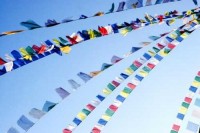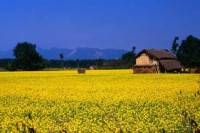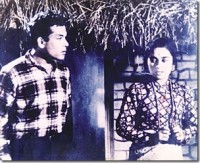Lung Ta, the Prayer Flags in Nepal
A prayer flag is a colorful panel of rectangular cloth, often found strung along mountain ridges and peaks high in the Himalayas.
Traditionally, prayer flags come in sets of five, one color in each of the five. The five colors represent the elements and are arranged from left to right in specific order: blue, white, red, green, and then yellow. Different elements are associated with different colors for specific traditions and purposes. Blue symbolizes sky/space, green symbolizes air/wind, red symbolizes fire, white symbolizes water while yellow symbolizes the earth. According to traditional Tibetan medicine, health and harmony are produced through the balance of the five elements.
There are two kinds of prayer flags: horizontal ones, called Lung Ta (meaning ‘Wind Horse’) in Tibetan, and the vertical Darchor. Dar translates as ‘to increase life, fortune, health and wealth’, and Cho translates as ‘all sentient beings’. Among these two, the former one is the most common one in Nepal.
Traditionally, prayer flags are used to promote peace, compassion, strength, and wisdom. The Tibetans believe the prayers and mantras will be blown by the wind to spread the good will and compassion into all pervading space. The flags are sensitive to the slightest movement of the wind. As wind passes over the surface of the flags, the air is purified and sanctified by the Mantras. Therefore, prayer flags are thought to bring benefit to all.
So, the next time the wind brushes against your cheeks, try to listen to the mantras that comes straight from the Lung Ta.





